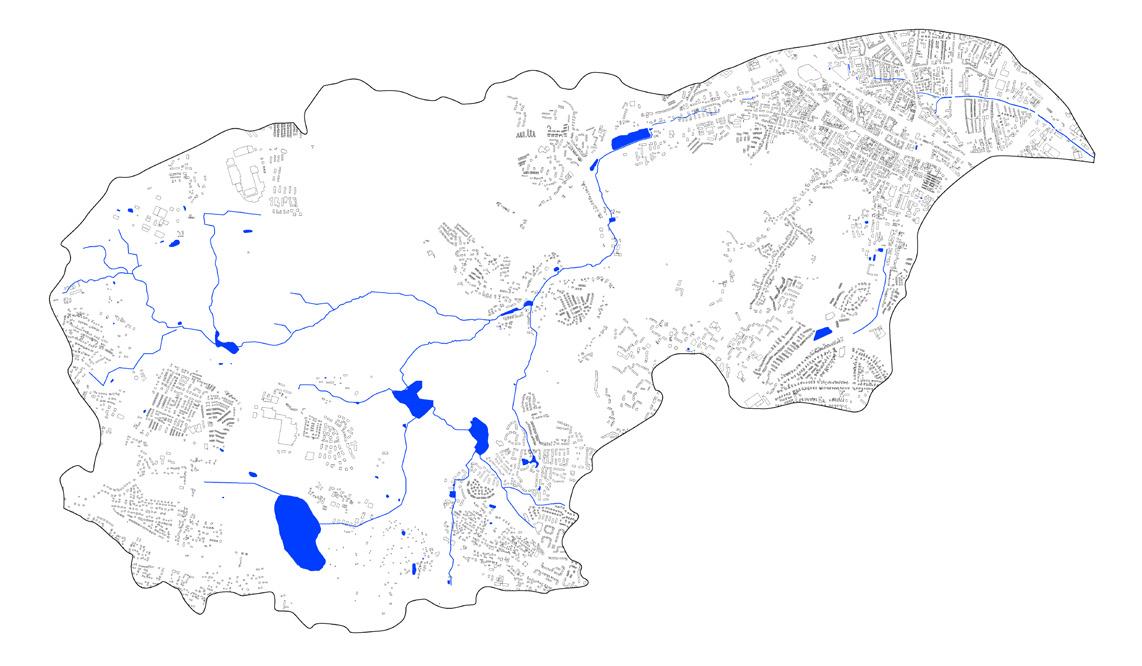2 minute read
C horeographing resilience
Choreographing community resilience along the flooding and disappearing Strzyza stream
Author: Justyna Kinga Chmielewska chmielewska.justyna.kinga@gmail.com
Landscape Architecture Master Thesis
Amsterdam Academy of Architecture
Committee members: Nikol Dietz (mentor), Jarrik Ouburg, Anna Fink
External committee: Berdie Olthof, Marie-Laure Hoedemakers
Amsterdam, Neteherlands, 2022/2023
Print/Bind: Drukkerij Raddraaier
Presenting seven gardens that restore the Strzyza’s presence, ecology and natural capacity to store rainwater.
By uncovering pieces of the buried underground stream, people who live around it can recognize its presence and learn how to coexist with it.
Through movement and little gestures of care: DIY work (re-arranging found materials, gardening and maintenance) people can reengage with the forgotten stream and acknowledge they are living in the flood zone. All of the choreographed actions improve the preparedness of communities for living in the floodplains of the Strzyza.
These gardens can serve as exemplary spaces, which highlight the buried and forgotten Strzyza: a catalyst for changing habits and controlling mindsets towards nature.
Each year there are fewer of them. Some have disappeared underground, from time to time reappearing in a littered ditch between buildings, to sink again somewhere below ground. This is the fate of the Strzyza and other tributaries of the Vistula river.
Almost all of Vistula’s tributaries have disappeared from the landscape of Polish cities. In Poznan the stream was interrupting city’s development, so it was rerouted. In Krakow all rivers except the Vistula have disappeared. Wrocław’s streams were forgotten. They disappeared and when they reappeared during flooding, 40% of the city was underwater. Each summer the Rawa stream gradually dried up until one day it completely vanished from Katowice. In Gdansk, two kilometres of Strzyza were channelled through underground pipes.
Over the past 30 years I have observed the slow disappearance of the Strzyza from the landscape of my hometown. I still remember the Strzyza from my childhood, when together with my grandfather Leon we visited Strzyza’s lush riparian forest. For us the forest around Strzyza was a collective home that provided shelter during hot summer days. Slowly, shopping malls and highways replaced the forest. As the stream started disappearing right in front of our eyes, my grandfather’s favourite word simply became ‘Strzyza’. The name of the stream became so stuck in my head that I decided to find out why it disappeared and how could I bring it back.
Lost Stream
The government buried two kilometres of the Strzyza underground, selling the land to diverse investors. In present days, some stretches of the Strzyza belong to commercial companies, some to privatized neighbourhoods, and the rest is still owned by Gdansk’s municipality. As a result, the creek has no coherent planning, and many parts of it have uncontrollably disappeared underground.

Map of Poland. Vistula river crosses Poland from mountains to Baltic Sea; Fig. 4: Pomorskie province and its regional importance in draining the Moraine Plateau from the rainwater is big; Fig. 5: City of Gdansk with its water system. Strzyza’s watershed (grey) is the last tribuary of Vistula river and a drainage of the moraine plateau; Fig. 6: Strzyza’s watershed. The stream starts in a forest (140 m npm) and streams down through the city of Gdansk (0 m npm).




Strzyza remains invisible for most parts of the year (Fig. 7A, 7B). It reappears only during big city floods (Fig. 8A, 8B). The urbanised part of the creek is canalised or placed underground in concrete pipes. geometrically shaped canal system of the creek leads to dangerous flash floods that citizens have to deal with.






The consequences of burying the Strzyza in underground concrete pipes are catastrophic. The rainwater collected in the concrete channel of the creek has no place to go and floods reappear in the city. The invisible stream doesn’t warn its citizens about the upcoming floods. Besides the dangerous floods, losing the Strzyza led to losing our collective memories. During medieval times monks inhabited the stream, and thanks to its fast-flowing current and the local hops (Humulus lupus) they have produced beer. Nowadays there are only a few watermills left in the city, as memories of the stream’s once-prospering habitats. Not only have we lost touch with the richness of the river landscapes, but we have come to the point where we see our streams only when they flood.









